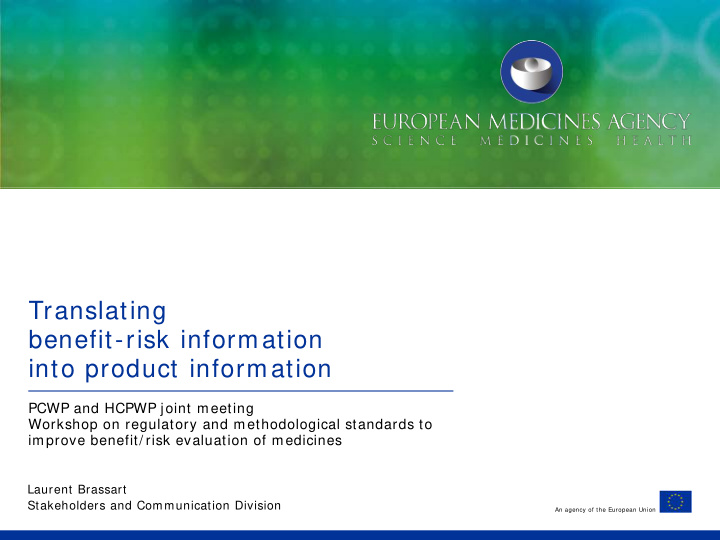



Translating benefit-risk information into product information PCWP and HCPWP joint meeting Workshop on regulatory and methodological standards to improve benefit/ risk evaluation of medicines Laurent Brassart Stakeholders and Communication Division An agency of the European Union
EU product information Package Leaflet Assessment report Summary of Product Characteristics European Public Assessment Report 1
EMEA/ PCWP/ HCP WG report on information on benefit-risk of medicines (23 June 2009, EMEA/ 40926/ 2009) Assessment at population level vs individual use Always communicate benefits and risks together Clear information to help choose most appropriate treatment Clear description of benefits and risks, both qualitative and quantitative Factors which may influence a benefit or a risk in an individual should be clearly described Concise information + detailed data 2
Summary of product characteristics (SmPC) - What is it and what does it contain? 3
SmPC information on benefits Section 5.1 “ Pharm acodynam ic properties ” summarises the benefits of the medicine in presenting: ● Its mechanism of action ● The main results of the clinical trials supporting the marketing authorisation - In giving the main characteristics of the patient population studied - And presenting the effects qualitatively and quantitatively ● Additional clinically relevant information in special populations: - In a balanced way (i.e. informing on uncertainties as appropriate) - Including study results in the paediatric population 4
SmPC information on risks • Section 4.8 “ Undesirable effects ” provides: – A sum m ary of safety profile (most serious and most frequently occurring adverse reactions) – A tabulated list of all adverse reactions with their respective frequency category – Information characterising specific adverse reaction – Information on clinically relevant differences in special population • Information on a specific risk is also reflected in section 4.4 “Special warnings and precautions for use” when the risk leads to a precaution for use or when healthcare professionals have to be warned of this risk 5
SmPC information for individualised care • SmPC information first addresses the recommendations that apply to the general population • The SmPC also provides dedicated information for these groups of patients, when relevant information is available • Information can be presented under specific subheading within each relevant section of the SmPC – Paediatric population, Elderly, Hepatic or renal impairment, Other concomitant diseases, Genomic factors, … • Or in dedicated section ; – e.g. Drug interaction, Pregnancy/ Lactation, Driving, Overdose 6
7
SmPC challenges in practice • Concise vs comprehensive information / Transparent vs unduly alarming • Efficacy - Main results (statistically compelling and clinically relevant) • Safety - Causal relationship – Frequency of adverse rections • Subpopulation with relevant clinical different efficacy or safety • Missing information • Drug interactions • Consistency between products and with therapeutic guidelines 8
Which efficacy results? Examples of endpoints in Rheumatoid Arthritis Example of analyses • ACR20 (50, 70) response criteria • DAS28 • swollen joint count • tender joint count • Patient pain • physical function (e.g. HAQ, AIMS) • patient global assessment of disease • physician global assessment of disease • Clinical remission • radiographic evidence • acute phase reactants (e.g. erythrocyte sedimentation rate, C-reactive protein) • … 9
Which safety information? Established Comparative adverse data reactions Combination use data Paediatric data All observed adverse Elderly events data Missing data Pharmacovigilance signal … 10
Consistency between products and with therapeutic guidelines • Products developed at different times • Different developments (endpoints, standard of care, populations, vs placebo or active comparator, in monotherapy or in combination, … ) • Different companies and marketing authorisation procedures • Different standards of care • Science is evolving 11
Promoting compliance and consistency SmPC Advisory Group 12
Package leaflet • Information on benefit-risk of medicines: patients’, consumers’ and healthcare professionals’ expectations - EMEA/ 40926/ 2009 • “the package leaflet could progress from a document on the use of the medicine (which may create fear in patients when reading the warnings and list of undesirable effects) toward an “information tool”. It should provide more information on benefits in understandable terms.” • To help supporting adherence to treatment 13
QRD product information annotated template (from July 2011) - benefits 14
Information on benefit in the PL • Clinical trials data should be interpreted in their context • How far can results be presented qualitatively and quantitatively in the PL in lay language? • Are quantitative measures suitable in the PL or should information be presented semi-quantitatively (e.g. delay, reduce, improve, prevent)? • Could comparative benefit information be presented? - vs placebo? - vs active comparator? Is information robust, evidence-based, clinically relevant and patient-oriented? 15
QRD product information annotated template 4. Possible side effects Reporting of side effects 16
Area for future discussion? • More information? • Comparative data? • Reference to therapeutic guideline? • Abstract? • Link to other documents (assessment reports, RMP, PL, … )? • Increased granularity? • More involvement of stakeholders in SmPC review (two-way communication + value judgement)? • … eHealth (e-prescribing tools) context? 17
Strengthening the link between the different information? Assessment Report(s) PL, Lab SmPC RMP EPAR summary summary RMP Educational material Therapeutic Safety guidelines information 18
Strengthening the link between the different information? Assessment Report(s) PL, Lab SmPC RMP EPAR summary summary RMP Educational material Therapeutic Safety guidelines information 19
Recommend
More recommend